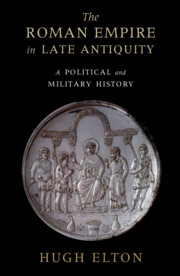69 results
LATE ROMAN FIELD ARMIES - (A.) Kaldellis, (M.) Kruse The Field Armies of the East Roman Empire, 361–630. Pp. xxii + 205, maps. Cambridge: Cambridge University Press, 2023. Cased, £85, US$110. ISBN: 978-1-009-29694-6.
-
- Journal:
- The Classical Review / Volume 74 / Issue 1 / April 2024
- Published online by Cambridge University Press:
- 27 December 2023, pp. 212-214
- Print publication:
- April 2024
-
- Article
-
- You have access
- HTML
- Export citation
LUKAS LEMCKE, BRIDGING CENTER AND PERIPHERY: ADMINISTRATIVE COMMUNICATION FROM CONSTANTINE TO JUSTINIAN. Tübingen: Mohr Siebeck, 2020. Pp. xii + 342. isbn 9783161589447. €69.00.
-
- Journal:
- The Journal of Roman Studies / Volume 112 / November 2022
- Published online by Cambridge University Press:
- 08 February 2022, pp. 342-343
- Print publication:
- November 2022
-
- Article
- Export citation
Chapter 16 - Fighting for Chalcedon: Vitalian’s Rebellion against Anastasius
- from Part III - Religious Violence in Late Antiquity
-
-
- Book:
- Religious Violence in the Ancient World
- Published online:
- 18 September 2020
- Print publication:
- 01 October 2020, pp 367-388
-
- Chapter
- Export citation
An incomplete account of the types of tomb monuments in Rough Cilicia - YASEMIN ER SCARBOROUGH , THE FUNERARY MONUMENTS OF ROUGH CILICIA AND ISAURIA (BAR International Series 2846; BAR Publishing, Oxford 2017). Pp. xvi + 292, figs. 308, including many in colour. ISBN 978-1-4073-1528-7. £47.00.
-
- Journal:
- Journal of Roman Archaeology / Volume 32 / 2019
- Published online by Cambridge University Press:
- 11 October 2019, pp. 900-903
- Print publication:
- 2019
-
- Article
- Export citation
Abbreviations
-
- Book:
- The Roman Empire in Late Antiquity
- Published online:
- 29 October 2019
- Print publication:
- 22 November 2018, pp ix-x
-
- Chapter
- Export citation
Illustrations
-
- Book:
- The Roman Empire in Late Antiquity
- Published online:
- 29 October 2019
- Print publication:
- 22 November 2018, pp vi-vii
-
- Chapter
- Export citation
Contributors
-
- Book:
- Archaeology and Urban Settlement in Late Roman and Byzantine Anatolia
- Published online:
- 09 November 2018
- Print publication:
- 22 November 2018, pp xi-xvi
-
- Chapter
- Export citation
Index
-
- Book:
- The Roman Empire in Late Antiquity
- Published online:
- 29 October 2019
- Print publication:
- 22 November 2018, pp 365-378
-
- Chapter
- Export citation

The Roman Empire in Late Antiquity
- A Political and Military History
-
- Published online:
- 29 October 2019
- Print publication:
- 22 November 2018
Contents
-
- Book:
- The Roman Empire in Late Antiquity
- Published online:
- 29 October 2019
- Print publication:
- 22 November 2018, pp v-v
-
- Chapter
- Export citation
1 - The Late Third Century, 260–313
-
- Book:
- The Roman Empire in Late Antiquity
- Published online:
- 29 October 2019
- Print publication:
- 22 November 2018, pp 5-50
-
- Chapter
- Export citation
Index
-
- Book:
- Archaeology and Urban Settlement in Late Roman and Byzantine Anatolia
- Published online:
- 09 November 2018
- Print publication:
- 22 November 2018, pp 369-378
-
- Chapter
- Export citation
Appendices
-
- Book:
- Archaeology and Urban Settlement in Late Roman and Byzantine Anatolia
- Published online:
- 09 November 2018
- Print publication:
- 22 November 2018, pp 257-318
-
- Chapter
- Export citation
Bibliography
-
- Book:
- Archaeology and Urban Settlement in Late Roman and Byzantine Anatolia
- Published online:
- 09 November 2018
- Print publication:
- 22 November 2018, pp 319-368
-
- Chapter
- Export citation
Introduction
-
-
- Book:
- Archaeology and Urban Settlement in Late Roman and Byzantine Anatolia
- Published online:
- 09 November 2018
- Print publication:
- 22 November 2018, pp 1-7
-
- Chapter
- Export citation
Maps
-
- Book:
- The Roman Empire in Late Antiquity
- Published online:
- 29 October 2019
- Print publication:
- 22 November 2018, pp viii-viii
-
- Chapter
- Export citation
Conclusion
-
- Book:
- The Roman Empire in Late Antiquity
- Published online:
- 29 October 2019
- Print publication:
- 22 November 2018, pp 351-352
-
- Chapter
- Export citation
7 - The Military Situation, 395–493
-
- Book:
- The Roman Empire in Late Antiquity
- Published online:
- 29 October 2019
- Print publication:
- 22 November 2018, pp 224-244
-
- Chapter
- Export citation
Notes on Names, Places, and Titles
-
- Book:
- The Roman Empire in Late Antiquity
- Published online:
- 29 October 2019
- Print publication:
- 22 November 2018, pp xi-xxii
-
- Chapter
- Export citation

